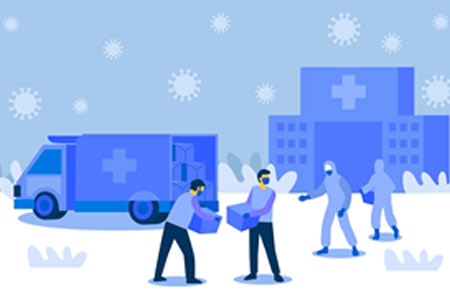Thank you for Subscribing to Healthcare Business Review Weekly Brief
Be first to read the latest tech news, Industry Leader's Insights, and CIO interviews of medium and large enterprises exclusively from Healthcare Business Review
Safe Passage: Rising Role of Medical Waste Transportation Services
Medical waste transportation services protect public health and the environment by ensuring compliant, tracked, and secure movement of hazardous healthcare refuse from source to safe disposal.

By
Healthcare Business Review | Wednesday, October 22, 2025
Stay ahead of the industry with exclusive feature stories on the top companies, expert insights and the latest news delivered straight to your inbox. Subscribe today.
Medical waste transportation services form a critical link in the healthcare lifecycle by moving infectious, pharmaceutical, chemical, and sharps waste from clinics, hospitals, laboratories, and long-term care facilities to treatment or disposal sites. Providers operate at the intersection of public health, environmental protection, and regulatory compliance, and demand for their services has grown with expanding healthcare delivery, complex supply chains, and rising volumes of diagnostic testing and home care.
Adequate transportation prevents the spread of pathogens, reduces environmental contamination, and preserves community trust in healthcare systems. Stakeholders from facility administrators to municipal regulators increasingly view transportation as an active safety control rather than a commodity, and they expect robust systems that deliver traceability, containment, and timely service while minimizing costs and carbon footprint.
Technology Implementation and Operational Design
Regulatory frameworks represent the foremost influence: national and regional laws define classification, packaging, labeling, and manifesting requirements, and they impose stiff penalties for improper handling. As regulators tighten rules and increase audits, healthcare facilities outsource transportation to specialists who maintain compliance expertise. Volume dynamics also matter: aging populations, expanding outpatient services, and the proliferation of point-of-care diagnostics and at-home care have multiplied waste generation points and quantities, forcing facilities to rethink centralized hauling schedules and route planning.
Cost pressures push hospitals to streamline waste streams and consolidate transportation contracts, yet they balance that against infection prevention imperatives that demand rapid pickup and safe segregation. Public awareness about environmental stewardship raises expectations for biosafety and zero-tolerance for illegal dumping, driving facilities and municipalities to demand transparent, verifiable transport systems. Public health events, such as pandemics, amplify demand spikes for hazardous waste removal and introduce new waste categories, including single-use PPE, testing swabs, and biologic materials, that require rapid scaling of collection and transport capacity.
Medical waste transport operators increasingly rely on technology to meet safety, compliance, and efficiency targets. GPS-enabled telematics provide real-time vehicle tracking, route optimization, and proof-of-service timestamps, improving on-time performance and supporting chain-of-custody reporting. RFID tags and barcode scanning on waste containers enable drivers and receiving facilities to verify contents against manifests, thereby reducing misclassification and reconciliation errors. Temperature-controlled trailers and insulated containment systems maintain cold-chain integrity for biologic samples or pharmaceutical waste. Providers implement sealed, tamper-evident containers and secure locking mechanisms to prevent diversion and accidental exposure to controlled substances.
Latest Trends and Expanding Applications
The industry evolves rapidly along several trends. Providers shift from point-to-point hauling to integrated, end-to-end waste management partnerships that bundle segregation training, onsite consolidation, pickup, transport, treatment, and final documentation. Healthcare networks prefer a single accountable vendor to reduce complexity and deliver performance SLAs. On-demand and micro-logistics models emerge to serve decentralized care settings, home health, urgent care clinics, and testing pop-ups where small but frequent pickups require flexible scheduling and smaller vehicle footprints.
Cross-border and regional consolidation grows as multinational healthcare players standardize vendor arrangements and demand interoperable documentation for international shipments of clinical samples and regulated wastes. Misclassification at source creates safety and liability risks; solution bundles combine staff education, clear labeling systems, and color-coded, pre-labeled containers to reduce human error. Vehicle and container contamination risk requires rigorous decontamination protocols, validated cleaning agents, and documented sanitization cycles. Cost pressures push providers to optimize route planning with telematics and dynamic scheduling while advocating for balanced contract terms that recognize disposal costs and regulatory obligations.
Security and diversion of regulated pharmaceuticals pose legal exposure; firms implement tamper-evident, locked containers, GPS geofencing, and strict chain-of-custody policies, and they conduct background checks and secure vetting for all drivers. Data integrity and documentation must meet audit standards; digital manifests, redundant backups, and blockchain options improve traceability and reduce disputes. Workforce shortages and training gaps can hamper safe operations; companies invest in competency-based training, certifications, and retention incentives to build skilled driver and technician pools.
Impact and Continuing Need
Medical waste transportation services deliver measurable public-good benefits. They prevent pathogen transmission by removing infectious material promptly and reliably, and they reduce environmental contamination by ensuring that hazardous fractions receive appropriate treatment instead of entering landfills or wastewater systems. Robust transport systems also expedite clinical workflows: clinicians and lab staff rely on predictable pickups to maintain clean environments and comply with hold times for specimens. From an economic perspective, efficient transport reduces facility downtime, avoids costly regulatory fines, and improves waste-cost forecasting.
The market grows not just in volume but in technical sophistication, integrating telematics, digital manifests, secure containment, and analytics to provide accountable, efficient, and scalable services. Providers that invest in compliance expertise, flexible logistics models, green mobility, and workforce development will lead the market and help healthcare systems manage risk while meeting sustainability targets. As healthcare ecosystems evolve, transportation firms will remain indispensable partners, carrying waste safely from source to treatment and enabling clinicians to focus on patient care with confidence.






